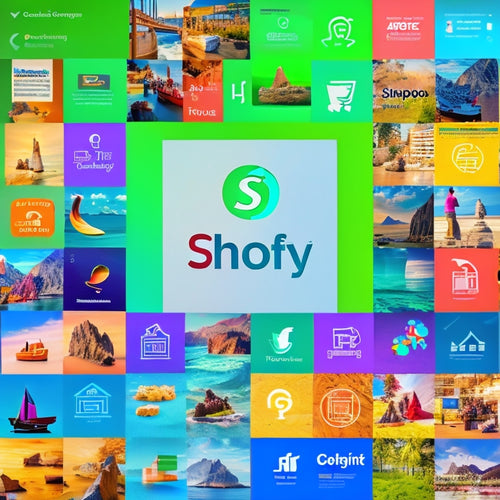
10 Proven Ecommerce Course Pricing Strategies Revealed
Share
You're likely leaving money on the table if you're not strategically pricing your ecommerce course. The right pricing strategy can increase revenue, attract high-caliber students, and set your course apart from the competition. From premium pricing for exclusivity to tiered pricing for variety, penetration pricing for new courses, and bundle deals for value, there are proven strategies to boost your sales. You can also analyze competitors' pricing, use psychological pricing tactics, or employ decoy pricing to drive sales. By applying these strategies, you can optimize your pricing for maximum revenue and growth. Now, explore these 10 ecommerce course pricing strategies to reveal your course's full potential.
Key Takeaways
• A premium pricing strategy can boost revenue and attract high-caliber students by positioning the course as a high-end offering with exceptional quality and personalized attention.
• Tiered pricing allows customers to self-select based on budget and needs, capturing a wider range of customers and increasing revenue potential with customized tiers.
• Penetration pricing can attract price-sensitive customers with a low initial cost, building a loyal customer base and brand awareness before refining the product and increasing the price.
• Bundle deals can increase average order value and customer satisfaction by crafting limited-time, tiered, and exclusive bundles that offer more value to customers.
• A competitive pricing analysis helps position the course to capture a larger market share by understanding course value, customer willingness to pay, and identifying gaps in the market.
Premium Pricing for Exclusivity
By positioning your ecommerce course as a high-end offering, you're leveraging premium pricing for exclusivity, which can greatly boost your revenue and attract high-caliber students who are willing to pay top dollar for exceptional quality and personalized attention. This luxury exclusivity approach allows you to differentiate your course from the masses, creating a sense of prestige and scarcity that justifies the higher price point.
When done correctly, high-end positioning can lead to a significant increase in revenue, as students are willing to pay a premium for exclusive access to valuable knowledge and personalized support.
To execute this strategy effectively, focus on creating an exceptional learning experience that justifies the premium price. This may include personalized coaching, exclusive access to industry experts, or high-quality video content. By delivering an unparalleled level of quality and service, you'll be able to attract high-caliber students who are willing to pay top dollar for the best.
Tiered Pricing for Variety
Offering multiple tiers of your ecommerce course at varying price points can help you tap into a broader customer base, as customers can self-select into the level of access and support that aligns with their budget and needs. By creating customized tiers, you can cater to different segments of your target audience, from beginners to advanced learners. This approach allows you to capture a wider range of customers, increasing your revenue potential.
To take it a step further, consider offering personalized bundles that combine specific tiers with additional resources or services. For instance, a 'starter' tier might include basic course materials, while a 'pro' tier adds one-on-one coaching and priority support.
Penetration Pricing for Newbies
When you're launching a new ecommerce course, penetration pricing can be a strategic move to quickly gain traction and attract price-sensitive customers who are enthusiastic to try out your product at a low cost. By setting an initial low price, you can create a buzz around your product, drive sales, and build a loyal customer base.
However, it's essential to conduct thorough market research and competitive analysis to determine the best price point that will give you a competitive edge without sacrificing your profit margins. You need to understand your target audience's willingness to pay, your competitors' pricing strategies, and the perceived value of your product.
With penetration pricing, you can test the waters, gather feedback, and refine your product before increasing the price later on. By doing so, you'll be able to attract a large customer base, build brand awareness, and ultimately drive long-term revenue growth.
Bundle Deals for Value
Craft a bundle deal that combines your ecommerce course with complementary products or services to increase the perceived value, and you'll be surprised at how it can skyrocket your average order value and customer satisfaction. This strategy allows you to offer more value to your customers while increasing your revenue.
Here are three ways to create a compelling bundle deal:
-
Limited time bundle: Offer a special bundle deal for a limited time to create a sense of urgency. This will encourage customers to make a purchase sooner rather than later.
-
Tiered bundle: Create a tiered bundle deal that offers more value as the customer spends more. For example, a basic bundle for $100, a premium bundle for $200, and an ultimate bundle for $500.
-
Exclusive bundle: Create an exclusive bundle deal that's only available to a select group of customers. This could be a special offer for loyal customers or those who've referred friends to your course.
Skim the Competition Pricing
By analyzing your competitors' pricing strategies, you can identify gaps in the market and position your ecommerce course to capture a larger share of the revenue pie. This competitive analysis is essential in understanding what works and what doesn't in your industry. You'll uncover the sweet spot where your course's value meets customer willingness to pay.
Skim the competition pricing strategy involves identifying the average price range of similar courses in your niche. You can then position your course above or below this range, depending on your unique selling proposition (USP).
If your course offers more extensive content, personalized support, or exclusive resources, you can justify a premium price. Conversely, if you're targeting budget-conscious customers, you can undercut the competition.
Price Anchoring for Context
You've analyzed your competitors' pricing strategies, now it's time to create a psychological pricing framework that influences customer perceptions, and that's where price anchoring for context comes in. This strategy is rooted in anchoring psychology, which suggests that customers perceive value based on the first piece of information they receive.
By presenting a higher 'anchor' price, you can make your actual price seem more reasonable by comparison.
Here are three ways to apply price anchoring for context:
-
High-Low Anchoring: Display a higher 'list price' or 'MSRP' next to your actual sales price to create a perceived discount.
-
Bundle Anchoring: Offer a bundle deal with a higher price point than the individual items, making the individual prices seem more reasonable.
-
Premium Anchoring: Place your product next to a higher-priced premium option, making your product seem like a more affordable choice.
Decoy Pricing for Options
When implementing decoy pricing for options in your ecommerce course, you'll want to strategically position your prices to influence customer behavior.
By anchoring the middle option, making expensive look cheap, and creating a middle ground, you can nudge customers towards the option that maximizes your revenue.
Anchor the Middle Option
Set your ecommerce course pricing strategy up for success by anchoring the middle option, a clever decoy pricing tactic that influences customers to choose the option that's most profitable for you. This pricing psychology trick works by presenting three options to customers, with the middle option being the most desirable. By doing so, you're leveraging consumer behavior to drive sales and increase revenue.
Here's how to execute this strategy effectively:
-
Create a clear hierarchy: Offer a basic, middle, and premium option to establish a clear hierarchy in the customer's mind.
-
Make the middle option attractive: Secure the middle option as the most appealing by providing the best value or most features.
-
Price the middle option strategically: Price the middle option slightly higher than the basic option, but lower than the premium option, to establish a sense of value and affordability.
Make Expensive Look Cheap
By strategically positioning a more expensive option alongside your target product, decoy pricing for options makes the latter appear more affordable, increasing the likelihood of customers choosing it. This psychological pricing tactic works by creating a reference point that makes your target product seem like a better value.
When you present a higher-priced option, customers perceive your target product as a discount, even if it's not actually discounted. This discount perception strategy is powerful because it influences customers' purchasing decisions on a subconscious level.
You can apply decoy pricing for options in various ways, such as offering a premium version of your product or service, or creating a bundle deal that includes additional features or services. The key is to make sure the more expensive option is visible and appealing, but not so appealing that it overshadows your target product.
Create a Middle Ground
Creating a middle ground with decoy pricing for options involves positioning your target product between two other options, one more expensive and one less expensive, to make it appear as the most reasonable choice. This strategy is effective because it influences your customers' perception of value.
By presenting a mid-range option, you're creating a psychological anchor that makes your target product seem like a better deal.
Here are three ways to create a middle ground:
-
Mid-range pricing: Offer a mid-range option that's more expensive than the basic option but cheaper than the premium option. This encourages customers to opt for the mid-range option, which is often the most profitable.
-
Discount strategies: Offer a discount on the mid-range option to make it more appealing. This creates a sense of urgency and encourages customers to make a purchase.
-
Price negotiation: Use the mid-range option as a starting point for price negotiation. If a customer tries to negotiate the price, you can offer the mid-range option as a compromise.
Loss Leader Pricing Strategy
You'll often find that ecommerce brands use the loss leader pricing strategy to lure customers in with an unbeatable deal on a popular product, knowing they'll make up for the losses on that item with complementary sales. This strategy is a powerful way to gain a competitive advantage, as it attracts price-sensitive customers who are keen to snag a good deal. By offering a loss leader, you'll not only drive sales but also increase brand loyalty.
When customers feel they've scored a great deal, they're more likely to return to your store and make future purchases. To execute this strategy effectively, identify a product with high demand and low profit margins. Then, price it competitively to attract customers. Make sure to pair this product with complementary items that have higher profit margins. This will ensure you recoup your losses and increase overall revenue.
Dynamically Priced for Scarcity
As inventory levels dwindle, dynamically pricing products for scarcity can become a lucrative strategy, allowing you to capitalize on the fear of missing out and willingness to pay a premium for hard-to-find items. By leveraging dynamic pricing, you can increase revenue and profit margins, even as stock levels decrease.
Here are three ways to implement dynamic pricing for scarcity:
-
Tiered pricing: Set multiple price points for the same product, with higher prices for lower inventory levels. This creates a sense of urgency, encouraging customers to buy sooner rather than later.
-
Countdown pricing: Display a countdown timer on your product page, showing the remaining quantity or time until the product is sold out. This creates a sense of FOMO, driving sales and revenue.
-
Limited-edition pricing: Create limited-edition products or bundles, available only while supplies last. This scarcity marketing tactic can lead to increased demand and higher prices.
Value-Based Pricing for Results
When you shift to value-based pricing for results, you're aligning your course's price with the tangible outcomes students can expect to achieve.
You'll focus on the desired outcome your students want to attain, and then create measurable result tiers that justify premium value markups.
Desired Outcome Focus
Desired Outcome Focus
By focusing on the desired outcome, you can set prices that reflect the tangible results your ecommerce course delivers to students, shifting the perceived value from the course itself to the benefits it provides. This approach allows you to prioritize customer satisfaction, ensuring that your students achieve their goals and see a clear return on investment.
To optimize your pricing strategy, consider the following:
-
Identify key performance indicators (KPIs): Determine the specific metrics that measure the success of your students, such as increased sales or improved website conversions.
-
Quantify the value proposition: Calculate the monetary value of the results your course provides, such as the average increase in revenue per student.
-
Tier pricing based on outcome levels: Offer different pricing tiers that correspond to varying levels of outcome achievement, incentivizing students to aim for higher results.
Measurable Result Tiers
You can create Measurable Result Tiers by defining specific, achievable outcomes that align with your students' goals, and then assigning tiered pricing based on the level of results they can anticipate to achieve. This strategy allows you to segment your pricing, catering to different customer needs and expectations.
By doing so, you'll not only increase customer retention but also boost your profit margins. Conduct a cost analysis to determine the resources required to deliver each tier's outcomes, and price accordingly.
For instance, a basic tier might promise a 20% increase in sales, while a premium tier guarantees a 50% boost. Charge accordingly, and students will be motivated to opt for the tier that best aligns with their goals. This approach guarantees that your pricing reflects the value you provide, rather than just the cost of production.
Premium Value Markups
By applying premium value markups, you can capitalize on the transformative results your ecommerce course delivers, charging students based on the tangible value they'll gain from your instruction. This value-based pricing strategy allows you to command a premium for your high-impact course, positioning it as a luxury offering that justifies its elevated price tag.
To successfully implement premium value markups, consider the following:
-
Luxury branding: Create a high-end brand image that resonates with your target audience, conveying exclusivity, sophistication, and exceptional quality.
-
Exclusivity marketing: Emphasize the limited availability or unique nature of your course, making students feel like they're part of an elite group.
-
Results-focused messaging: Clearly communicate the specific, measurable outcomes students can expect from your course, highlighting the tangible benefits they'll gain.
Frequently Asked Questions
How Often Should I Adjust My Ecommerce Course Pricing Strategy?
You should adjust your ecommerce course pricing strategy quarterly, based on competitive analysis, customer segmentation, and market trends, to stay competitive and maximize revenue, but avoid frequent changes that confuse customers.
Can I Combine Multiple Pricing Strategies at Once Effectively?
"Fasten your seatbelt, because you're about to turbocharge your pricing strategy! You can combine multiple strategies effectively, like bundle pricing and tiered pricing for value-driven customers, or psychological pricing with a freemium model to hook them in."
Do Discounts Negatively Impact My Brand's Perceived Value?
When you offer discounts, you risk diluting your brand's perceived value, as customers may view your products as less exclusive or premium, ultimately impacting your branding and long-term profitability.
How Do I Determine the Optimal Price for My Ecommerce Course?
To determine the best price for your ecommerce course, you'll need to conduct competitive analysis and consumer research to understand your target audience's willingness to pay, then leverage your unique value proposition and pricing psychology to set a price that drives sales and revenue.
What Metrics Should I Track to Measure Pricing Strategy Success?
You'll want to track customer retention rates, profitability, and revenue growth to measure pricing strategy success. Additionally, stay on top of competitive analysis and market trends to guarantee your strategy remains competitive and optimized.
Related Posts
-

What Is Social Proof Shopify
This article examines the concept of social proof on Shopify, a popular e-commerce platform. The objective of this a...
-

Ultimate Guide to Shopify SEO: Boost Your Store's Ranking in 2022
This article serves as an ultimate guide to Shopify SEO, offering insights and strategies for Shopify store owners t...
-

Top Shopify Apps for Ecommerce Growth
This article provides an overview of the top Shopify apps for ecommerce growth. The background information includes ...


